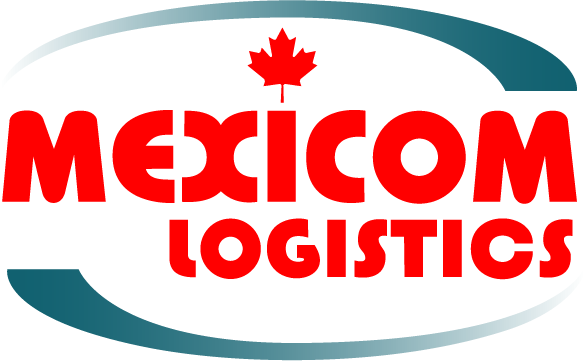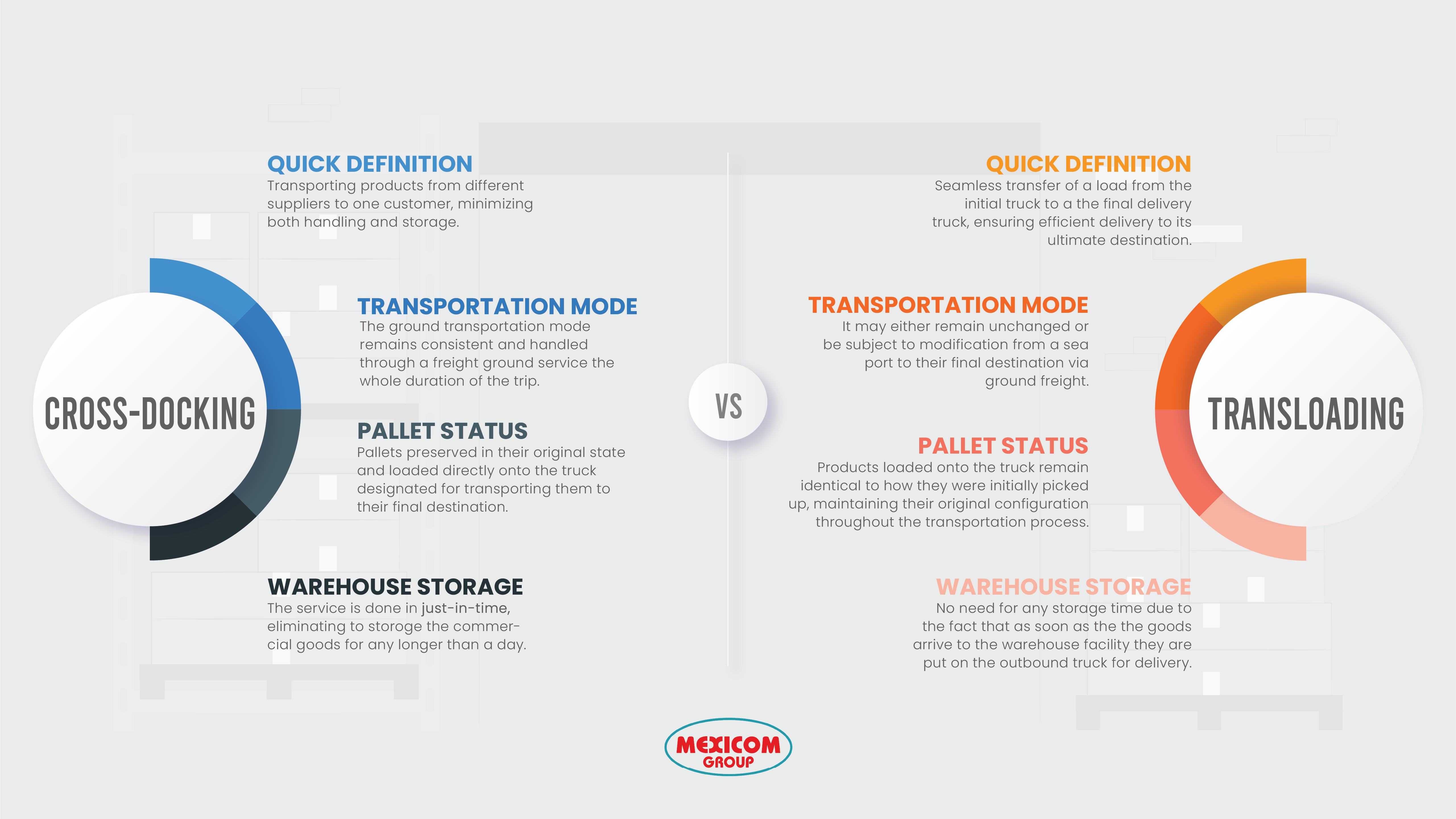Here’s All You Need To Know To Choose Between Cross-Docking and Transloading
Here we are delving into the difference between a cross-docking service and a transloading service. These two are both concepts in logistics that streamline the transportation of goods. Both methods of transportation aim to enhance operational efficiency, reduce costs, and expedite the delivery of commercial goods. As we explore the definitions and examples of cross-docking and transloading, we will also analyze the beneficial operations of each, comparing and contrasting their impacts on cost reduction, inventory management, risk mitigation, and storage time. This exploration aims to provide a comprehensive understanding of these essential logistics strategies and their implications for businesses engaged in the movement of goods.
Defining Cross-Docking
Cross-docking is a logistics procedure characterized by transporting products from different suppliers to one customer, minimizing both handling and storage. This process involves the transfer of cargo from one inbound freight truck to another outbound truck, typically occurring at a distribution dock terminal. The main goal of the cross-docking service is to reduce costs associated with transportation, warehousing, and storage.
The cross-docking procedure involves unloading merchandising goods from one transport and positioning them on a loading dock. When it’s time to transfer the materials, they are moved to a second dock. This movement from one dock to another created the term “cross-docking”.
To make this definition clear here’s an example:
A manufacturer is shipping 20 pallets of commercial goods from the U.S. East Coast to three different destinations in Mexico. First, the 20 pallets are sent to our warehouse location in Laredo, TX. Then only 5 of those pallets are sent in a truck to Destination 1 in Mexico, 10 pallets are sent to Destination 2 in a different truck, and the last 5 are sent to Destination 3 on an outbound truck. Since the pallets were never unpacked, only moved from one truck to another, and were in the warehouse just for the time needed to make this move. After this is done it is said that the shipment has been cross-docked, meaning it went from one dock to another dock in a warehouse as fast as possible to get to their final destinations.
Defining Transloading
Transloading in Mexicom logistics signifies the seamless transfer of a load from the initial truck to a the final delivery truck, ensuring efficient delivery to its ultimate destination. The truck originating from the pickup point makes a stop at our warehouse facility. Here, the commercial goods are strategically transferred to a truck capable of reaching the drop-off location. This process guarantees the safety of all transferred items and enhances the overall quality of our logistics services.
To make this definition clear here’s an example:
A truck is set to embark on a journey from Mexico City to its ultimate destination in Montreal. The initial leg of this transportation involves a Mexican truck picking up the load and transporting it to Laredo, TX, which serves as the first stop on the route. At this warehouse facility, the commercial goods undergo a seamless transfer from a Mexican truck to an American truck, marking a transition in the journey. Once the load is transferred from the Mexican truck to the American one, there will be no further stops, and the cargo will proceed directly to its final destination in Montreal.
Beneficial Operations of Cross-Docking
Reduced Cost
Shippers can send complete truckloads to a third-party warehouse rather than much smaller LTL (Less Than Truckload) shipments. Merging various incoming products at a warehouse facility and loading them onto a single truck destined for the same final location results in a substantial reduction in costs and expedited delivery for all items. This streamlined approach enhances operational efficiency in the transportation process for those who look to deliver different products to one final destination. Benefiting both the logistics provider and the end recipients of the diverse products.
Inventory Management
Using the cross-docking service will reduce the necessity to maintain an extensive stock. Commercial goods move from the receiving area to outbound transportation, minimizing the duration of storage and eliminating the need for large storage space. The simplified inventory contributes to cost savings as well as improved responsiveness to market demands.
Less Risk of Damage
Commercial goods only stay for a brief storage duration within warehouse facilities, substantially mitigating the risks associated with theft and damage. The cross-docking does not involve the rearrangement of goods. Instead, it efficiently transfers commercial truck cargo directly to another truck with similar products without going through the merchandising. This approach minimizes the exposure of goods to potential damage or loss, as items are swiftly transferred without the need for prolonged storage or intricate handling.
Less Storage Time
Its minimal to nonexistent storage duration within warehouse facilities, makes this process advantageous, particularly in terms of reducing warehousing costs and enhancing delivery efficiency with products arriving to their final destination in a shorter period of time.
Beneficial Operations of Transloading
Reduced Cost
Opting for transloading, rather than direct transportation, when shipping commercial goods results in a cost reduction, most of the time making shipping affordable for customers.
Operational Logistics
Opting for a transloading service makes the operational logistics more functional in the shipping process. When transporting a load cross-border, facilitating the transfer of commercial goods from one local truck to another local truck makes the overall operation run smoother, mitigating potential international issues.
No Storage Needed
There is no storage involved when transloading loads. Warehouse facilities serve solely as a means for facilitating the transfer, eliminating the necessity to store commercial goods. The goods are dropped off exactly as they were initially arranged upon arrival, minimizing the need for additional storage within the warehouse facilities.
Cross-Docking vs. Transloading
Transportation Method
Within cross-docking services, the ground transportation mode remains consistent. This implies that even as the load undergoes a transfer from one truck to another, it continues to be handled through a freight ground service. In transloading, however, the transportation method may either remain unchanged or be subject to modification. In the Mexican portion of our service, Mexicom Logistics provides diverse sea ports where transloading of merchandise can take place. Subsequently, the goods are transported to their final destination via a freight ground service.
Pallets Status
In cross-docking, the pallets carrying products remain intact upon arrival at the warehouse; there is no disassembly involved. These pallets are preserved in their original state and loaded directly onto the truck designated for transporting them to their final destination. This process applies to both services, with the primary distinction being that in cross-docking, the products are consolidated into a single truck with other items bound for the same location. Which in transloading, the products loaded onto the truck remain identical to how they were initially picked up, maintaining their original configuration throughout the transportation process.
Guide to Choose the Most Beneficial Service for Your Needs
1. Consider the volume of goods being shipped
In cross-docking, items might meet specific size criteria to be consolidated with other items in the same outbound truck for shipping. On the other hand, transloading is more flexible in accommodating various shipment sizes, as when using a Full Truckload (FTL), the products remain unchanged even during the transfer.
2. Consider storage time and space
When seeking storage space for products, both cross-docking and transloading services operate within limited space and time. Cross-docking allows for a maximum of one day of storage, ensuring a swift and efficient process. In contrast, transloading does not incorporate storage capabilities into its service, as it primarily involves the direct transfer of products from one local truck to another, minimizing the need for extended storage periods.
3. Consider delivery speed
When looking for a faster turnaround transloading can act on a time-sensitive standard. With cross-docking even though the process happens fast it might require additional steps in the handling process.
4. Consider your supply chain needs
Is essential you look at your shipping necessities and be informed of the best options you have to successfully achieve an efficient supply chain. Knowing all the information there is in cross-docking can facilitate the decision. At Mexicom Group we take care of all our customers’ necessities and prioritize their needs. As well as give them valuable resources to make the best cross-border transportation decisions.
Perks of utilizing our transloading
- Transloading operations are all conducted at our local Laredo facility.
- Dedicated to guaranteeing the safe and secure transportation of goods.
- Full communication with the customer from the moment their commercial goods are in our possession until they arrive at their final destination. Providing photo evidence of the transfer process that ensures the good handling of the products.
- Our door-to-door service guarantees a smooth experience for all our customers.
An aspect that consistently earns high satisfaction from our clientele is our unwavering commitment to transparency and communication. Throughout the transloading process, we offer real-time updates and evidence, ensuring our clients that their commercial goods are handled with the utmost care and precision. We prioritize maintaining control and quality at each stage of the process. This principle extends to the entire freight shipping delivery, spanning from point A to point B across the regions of Canada, the United States, and Mexico. Comprehend the effective risk mitigation strategies implemented by Mexicom Group in transloading operations.
Perks of utilizing our cross-docking service
- We finish the service within a single day, eliminating the necessity for extended storage and providing a cost-efficient solution.
- We’ve set up a centralized hub that streamlines the cross-docking process for goods moving between Mexico and the United States.
- Utilization of a Warehousing Management System.
Our cross-docking procedure is meticulously crafted to facilitate the smooth transfer of goods directly from inbound trucks to outbound trucks, minimizing storage duration and optimizing distribution efficiency. This service adopts a ‘just-in-time’ approach, guaranteeing the prompt arrival of products at their designated destinations. This accelerated process enhances the agility of your supply chain, allowing for swift adaptation to market demands and a competitive edge.
Our team is committed to delivering a seamless, cost-effective, and environmentally conscious solution. Opting for a partner dedicated to your success ensures that your supply chain experiences efficiency, speed, and overall success in the ever-evolving realms of logistics and commerce. Mexicom USA has the ability to provide an outstanding cross-docking service.
In conclusion, being knowledgeable about these subjects when making decisions regarding the utilization of freight ground transportation services is crucial for businesses seeking to optimize their supply chain operations. The exploration of these methodologies has unveiled distinctive characteristics, advantages, and applications, offering businesses valuable insights into choosing the most fitting approach for their specific needs. Recognizing the differences in transportation methods, storage requirements, and overall efficiency between cross-docking and transloading with the unique demands of their cargo and operational objectives. Ultimately, informed decision-making is the cornerstone of achieving success and resilience in the realm of logistics and supply chain.
SOURCES:
https://www.indeed.com/career-advice/starting-new-job/cross-docking-vs-transloading












I’m thankful you informed us that transloading means the seamless transfer of load from an initial mode of transport to a final mode of transport to ensure an efficient delivery to its ultimate destination.